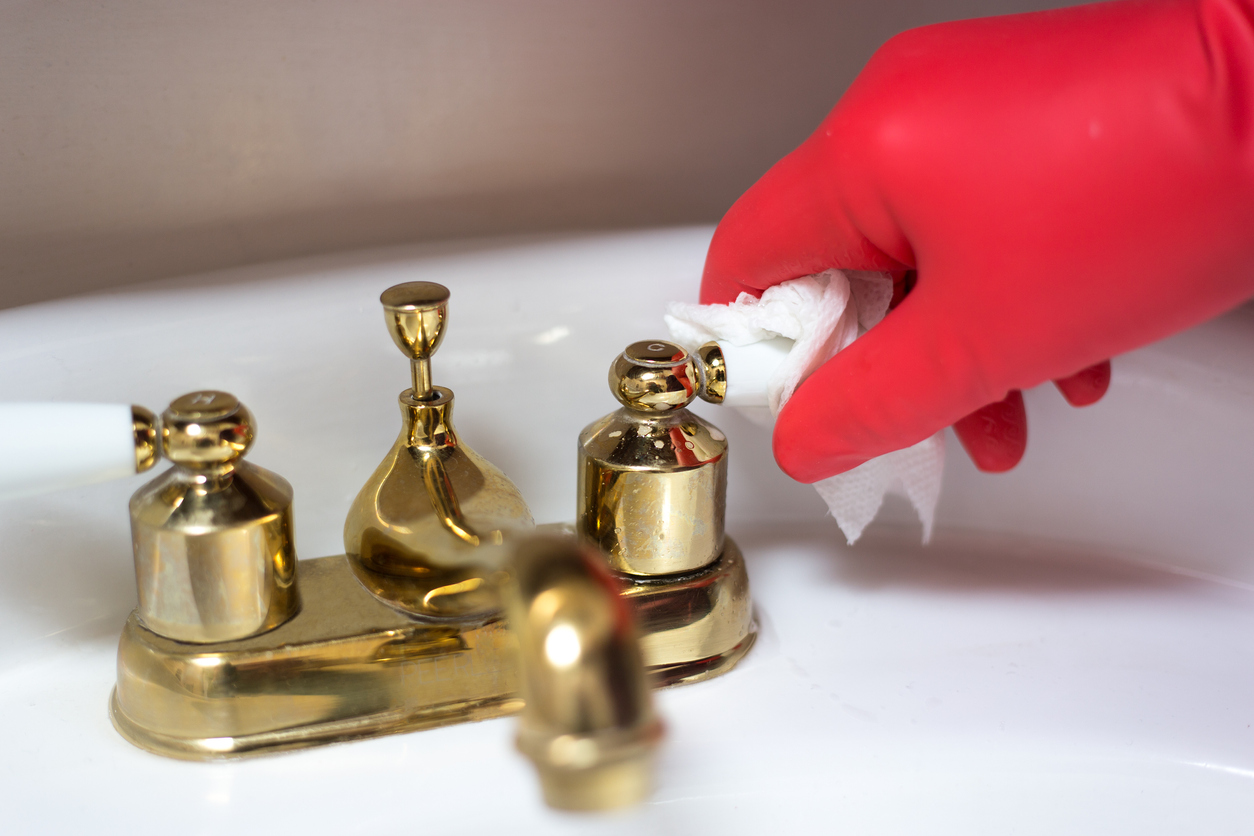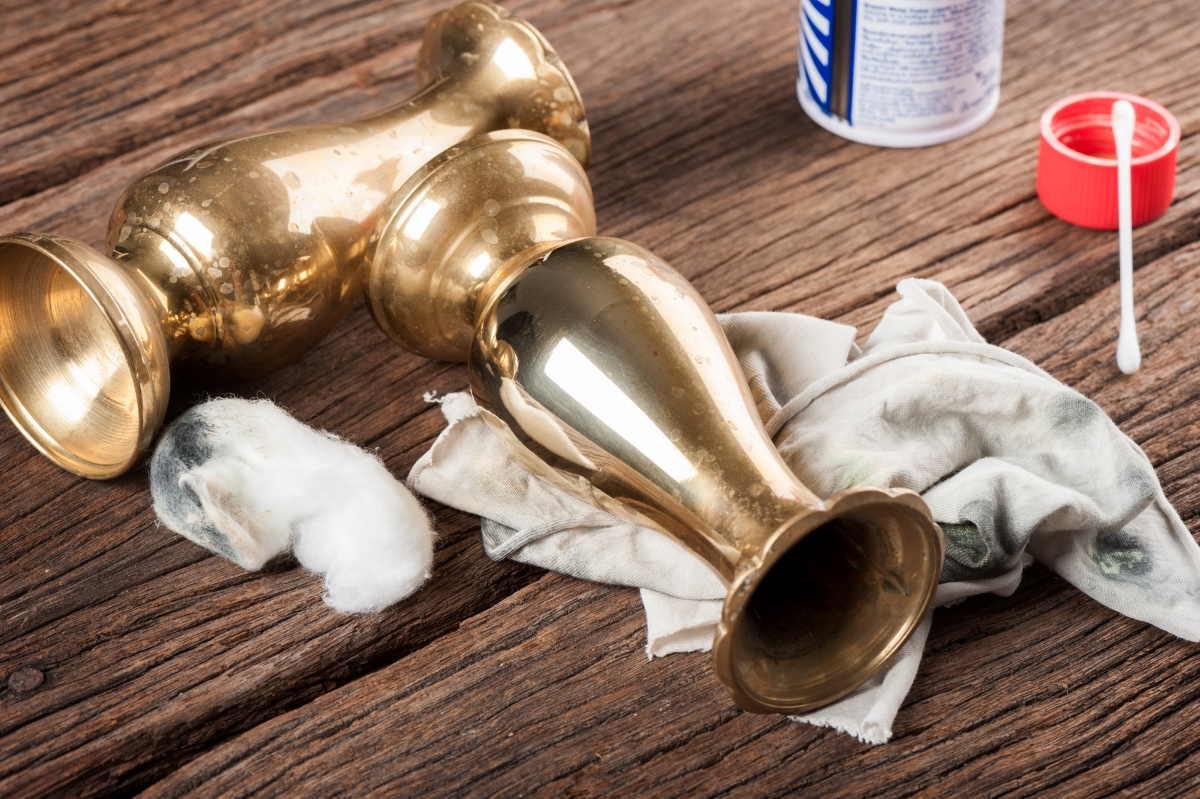We may earn revenue from the products available on this page and participate in affiliate programs. Learn More ›
Brass brings a warm, burnished glow to household items, ranging from switch plates and door knockers to bathroom fixtures, furniture, and even kitchen utensils. A strong and corrosion-resistant metal, brass is a relatively inexpensive alloy made from zinc and copper. Its bright golden color has made the material incredibly popular in home design.
Like any metal, brass can become dull and tarnished over time. The good news is that all it takes is a few pantry ingredients and some elbow grease to restore its shine.
Tools & Materials
Bobvila.com may earn a commission from purchases made through these links.
Project Overview
Working Time: 1 hour
Total Time: 1 hour
Skill Level: Beginner
Estimated Cost: $0 to $10
Before You Begin
Before you start cleaning brass, make sure that the item you are cleaning is, in fact, brass. Metals like steel, zinc, and cast iron are often brass-plated and look like solid brass, but aren’t. If you attempt to clean these pieces brass-cleaning methods, you can damage them. The easiest way to determine if the piece you have is the real deal? Place a small magnet on the metal. Magnets will not stick to solid brass. If the magnet sticks, the piece is brass-plated.
RELATED: How to Clean Bronze
7 Easy and Effective Ways to Clean Brass
There are multiple ways to clean solid brass using either homemade brass cleaners or commercial cleaners. The best method for your situation depends on just how much dust, dirt, or tarnish is on the brass piece. Here are a few tips and techniques to try, beginning with the simplest.
1. Use a Microfiber Cloth

Start cleaning brass with hot soapy water and a microfiber cleaning cloth. Microfiber cloths comprise many tiny fibers that have a knack for capturing and removing small particles. They’re also incredibly soft and gentle, so they won’t scratch your brass piece.
Dip the cloth in the water and give all surfaces a once-over. After that, use a clean toothbrush to tackle any crevices. Rinse with warm water and dry thoroughly.
2. With Ketchup
For tougher brass stains, try ketchup. Ketchup contains acidic ingredients, like tomatoes and vinegar, which react with brass tarnish and help to dissolve it. You can also use tomato paste and tomato sauce for the same reason.
Simply rub a thin coat of ketchup on the brass, let it sit for an hour or so to work its magic, and then clean the piece with a microfiber cloth and hot soapy water.
3. With a Vinegar, Salt, and Flour Paste
Another way to clean brass is to make a paste of ½ teaspoon salt, ½ teaspoon flour, and ½ cup white vinegar. Vinegar’s acidity works to dissolve tarnish, while the salt’s gentle abrasive texture can remove tough stains. Meanwhile, the flour holds it all together to form a paste that’s easy to work with.
Simply apply the paste to the brass and let it sit for up to an hour. Rinse it with warm water and buff dry with a microfiber cloth.
4. With Lemon Juice
Another effective, natural cleaning combination for brass is salt and lemon. Lemon’s acidity combined with salt’s gentle abrasive texture work to dissolve and then scrub away dirt and tarnish.
Here’s how to do it:
- Cut a lemon in half and remove the seeds.
- Coat the cut half of the lemon with a thin layer of table salt before rubbing the lemon over the brass, re-coating the lemon with salt as needed.
- After covering the entire surface, let the solution sit for up to an hour.
- Rinse the item with warm water then dry and buff with a microfiber cloth.
5. Using Commercial Metal Polish
If DIY and natural methods fail to clean a brass item, you might turn to commercial metal cleaners and polishes like Brasso, Bar Keepers Friend, Nevr-Dull, Cameo, Hagerty and Blitz. You can also check out our roundup of the best brass cleaners. Just beware that some of these cleaners and brass polishers contain potentially hazardous ingredients such as oxalic acid, a corrosive agent that can cause headaches, dizziness, and nausea from inhaling fumes, along with more severe nervous system effects. Others can irritate skin or cause serious eye damage if they get into the eyes.
Instructions for how to polish brass with these metal cleaners will vary by product, but they typically involve applying the cleaner to the brass, letting it sit for up to an hour, then wiping and rinsing it away. Be sure to follow all safety instructions listed on metal cleaning products, such as wearing gloves or working in well-ventilated spaces. Also check cautions for storage to prevent combustion or accidental poisoning of children.
6. Scrub With Toothpaste

Toothpaste contains mild abrasives, like baking soda or hydrated silica, which can help break down tough brass stains. For this method, all you have to do is squirt a small amount of toothpaste onto a microfiber cloth and then wipe the cloth along all surfaces. You can follow up with a toothbrush to scrub small crevices, then rinse with warm soapy water.
7. With Lemon and Baking Soda or Cream of Tartar
Like toothpaste, baking soda and cream of tartar powder are mild abrasives that can help tackle stubborn brass stains. You can use either one for this method. To start, measure 1 teaspoon of either baking soda or cream of tartar and combine it with 2 teaspoons of lemon juice. Mix it up until it forms a paste. Use a microfiber cloth to apply the paste on all surfaces before rinsing with warm soapy water.
How to Keep Brass Looking Like New

To keep your brass looking like new, bear in mind the following tips.
- Avoid using highly abrasive scrubbing cloths, metal-bristle brushes, or steel wool; these will scratch the surface of the brass.
- To prevent tarnish, apply a thin coat of linseed oil or mineral oil to clean brass with a microfiber cloth.
- Remember that many brass objects are protected with a lacquer finish, which should be cleaned only with hot soapy water. If these pieces are heavily tarnished, you’ll need to remove the lacquer with a paint or varnish remover. Then clean and polish the brass using one of the techniques above and re-lacquer the piece.
- Avoid touching brass items as much as possible; oils in your skin can hasten tarnishing.
RELATED: 10 Brushed Gold Fixtures for Your Kitchen or Bath Reno
FAQs
Still have burning questions about spiffing up your brass? Here are answers to popular questions about brass cleaning.
Q: Does brass rust?
No, brass does not rust. In order for a metal to rust, it needs to contain iron, which reacts with water and oxygen to form rust. Brass primarily comprises zinc and copper. If there is some iron present, it’s not enough to create rust.
Q: How do you prevent brass from tarnishing?
There are a few ways to prevent brass from tarnishing and maintain its luster:
- Don’t touch brass pieces very often—the oil from your hands can lead to tarnish
- Avoid keeping brass in humid or moisture-prone areas
- Regularly clean your brass with a microfiber cloth and warm water
- Never use harsh chemicals or highly abrasive cleaning tools
- Apply a thin coat of linseed oil or mineral oil to clean brass with a microfiber cloth to make it shine
Q: How do you clean brass jewelry?
Once you know how to clean brass hardware and other pieces, you pretty much already know how to clean brass jewelry. You can generally use the same cleaning solutions and methods as you would with other brass pieces. However, it’s not recommended to completely submerge brass jewelry in any cleaning solution since it can potentially damage tiny components like adhesives, or even some gemstones. And since jewelry is usually more delicate than other brass pieces, take extra care that you don’t scrub too hard when cleaning brass jewelry.
Q: What happens if I use solid brass cleaning methods on brass-plated materials?
Solid brass cleaning methods are different from brass-plated methods. Brass-plated items should typically only be cleaned with hot soapy water. Using other cleaning solutions or rubbing and polishing these pieces too aggressively can remove the brass plating and ruin the piece.
Final Thoughts
Periodically cleaning and polishing your brass with a microfiber cloth will help to maintain its luster. But when tarnish and stains do inevitably appear, you probably already have the products you need to clean it. Once your brass looks like new again, you can learn about other metal cleaning methods, like how to polish silver.

